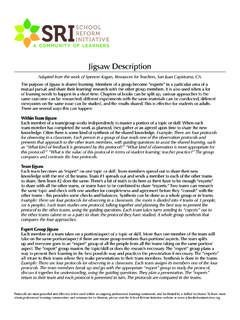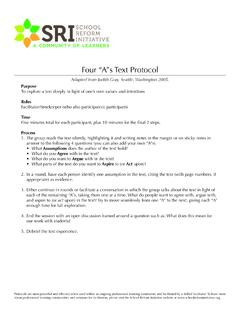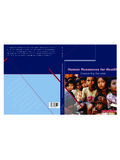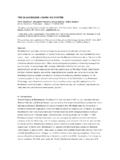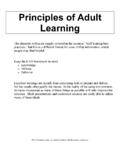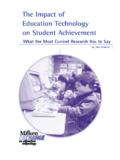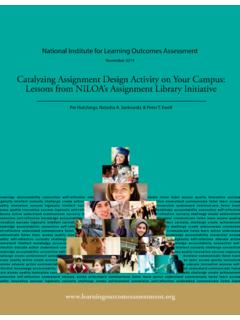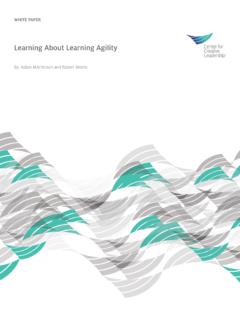Transcription of ATLAS: Learning From Student Work - School Reform Initiative
1 Protocols are most powerful and effective when used within an ongoing professional Learning community and facilitated by a skilled facilitator. To learn more about professional Learning communities and seminars for facilitation, please visit the School Reform Initiative website at : Learning From Student WorkSelecting Student work to ShareStudent work is the centerpiece of the group discussion. The following guidelines can help in selecting Student work that will promote the most interesting and productive group discussions: Choose assignments that involve lots of thinking and that give students some freedom in how they approach the task. Avoid work that consists primarily of answers with little explanation or that involves the application of a well-defined procedure.
2 At times it may be useful to share several pieces of Student work that show different approaches to the same assignment. Ambiguous or puzzling work tends to stimulate the best discussions. Since it does not readily match expectations, it encourages close attention to details and affords multiple interpretations. If this feels uncomfortable, it may be useful to start by examining anonymous samples of Student work collected from within the group or gathered from other sources. Another approach for selecting Student work is for the group to plan a classroom activity jointly, teach it independently, then bring the Student work back to the group for discussion. This approach is a good way to begin examining teaching or assessment practices based on what the group has learned from looking at Student work .
3 Sharing and Discussion of Student WorkDiscussions of Student work sometimes make people feel on the spot or exposed, either for themselves or for their students . The use of a structured dialogue format provides an effective technique for managing the discussion and maintaining its focus. A structured dialogue format is a way of organizing a group conversation by clearly defining who should be talking when and about what. While at first it may seem rigid and artificial, a clearly defined structure frees the group to focus its attention on what is most important. In general, structured dialogue formats allot specified times for the group to discuss various aspects of the the Student whose work is being examined to be a silent member of the group.
4 Assume, as for any member, that the Student is acting in good faith and has put forth his or her best effort. Reflecting on the ProcessLooking for evidence of Student thinking: What did you see in this Student s work that was interesting or surprising? What did you learn about how this Student thinks and learns? What about the process helped you to see and learn these things?Protocols are most powerful and effective when used within an ongoing professional Learning community and facilitated by a skilled facilitator. To learn more about professional Learning communities and seminars for facilitation, please visit the School Reform Initiative website at to colleagues thinking: What did you learn from listening to your colleagues that was interesting or surprising?
5 What new perspectives did your colleagues provide? How can you make use of your colleagues perspectives?Reflecting on one s own thinking: What questions about teaching and assessment did looking at the students work raise for you? How can you pursue these questions further? Are there things you would like to try in your classroom as a result of looking at this Student s work ?Protocols are most powerful and effective when used within an ongoing professional Learning community and facilitated by a skilled facilitator. To learn more about professional Learning communities and seminars for facilitation, please visit the School Reform Initiative website at : Learning From Student work Protocol1. Getting Started The facilitator explains the protocol.
6 Note: Each of the next 4 steps should be about 10 minutes in length. The presenter is silent until Step 5. The group should avoid talking to the presenter during steps 2-4. It is sometimes helpful for the presenter to pull away from the table and take notes. The educator providing the Student work gives a very brief statement of the assignment. The educator should describe only what the Student was asked to do and avoid explaining what she/he hoped or expected to see. The educator providing the work should not give any background information about the Student or the Student s work . In particular, the educator should avoid any statements about whether this is a strong or weak Student or whether this is a particularly good or poor piece of work from this Student .
7 Note: After the group becomes more familiar with this process for looking at Student work , you may find it useful to hear the educator s expectations. However, this information will focus more of the group s attention on the design of the assignment, the instruction, and the assessment, rather than on seeing what is actually present in the Student s work . The participants observe or read the work in silence, perhaps making brief notes about aspects of it that they particularly notice. 2. Describing the Student work The facilitator asks: What do you see? During this period the group gathers as much information as possible from the Student work . Group members describe what they see in the Student s work , avoiding judgments about quality or interpretations about what the Student was doing.
8 If judgments or interpretations do arise, the facilitator should ask the person to describe the evidence on which they are based. It may be useful to list the group s observations on chart paper. If interpretations come up, they can be listed in another column for later discussion during Step Interpreting the Student work The facilitator asks: From the Student s perspective, what is the Student working on? During this period, the group tries to make sense of what the Student was doing and why. The group should try to find as many different interpretations as possible and evaluate them against the kind and quality of evidence. From the evidence gathered in the preceding section, try to infer: what the Student was thinking and why; what the Student does and does not understand; what the Student was most interested in; and how the Student interpreted the from Student work is a tool to guide groups of teachers discovering what students understand and how they are thinking.
9 The tool, developed by Eric Buchovecky, is based in part on the work of the Leadership for Urban Mathematics Project and of the Assessment Communities of Teachers Project. The tool also draws on the work of Steve Seidel and Evangeline Harris-Stefanakis of Project Zero at Harvard University. Revised November 2000 by Gene Thompson-Grove for are most powerful and effective when used within an ongoing professional Learning community and facilitated by a skilled facilitator. To learn more about professional Learning communities and seminars for facilitation, please visit the School Reform Initiative website at Think broadly and creatively. Assume that the work , no matter how confusing, makes sense to the Student ; your job is to see what the Student sees.
10 As you listen to each other s interpretations, ask questions that help you better understand each other s Implications for Classroom Practice The facilitator asks: What are the implications of this work for teaching and assessment? Based on the group s observations and interpretations, discuss any implications this work might have for teaching and assessment in the classroom. In particular, consider the following questions: What steps could the teacher take next with this Student ? What teaching strategies might be most effective? What else would you like to see in the Student work ? What kinds of assignments or assessments could provide this information? What does this conversation make you think about in terms of your own practice?
